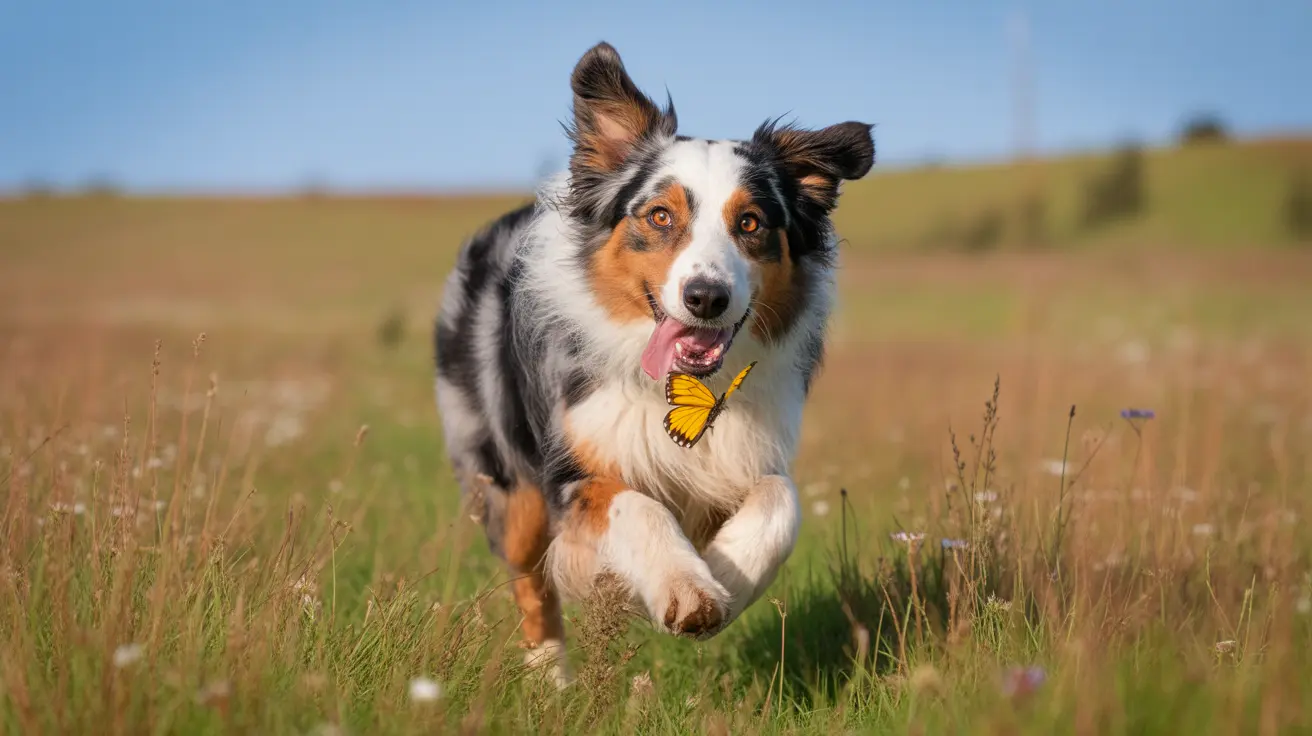Dog Exercise Off-Leash and On-Leash Needs: A Complete Guide to Balanced Canine Fitness
Every dog owner faces the fundamental question of how to provide their furry companion with adequate exercise while ensuring safety and proper behavior. The balance between on-leash control and off-leash freedom represents one of the most important decisions affecting your dog's physical health, mental well-being, and overall quality of life. Understanding when, where, and how to incorporate both forms of exercise into your dog's routine can transform their happiness and strengthen the bond you share.
Modern dog ownership often defaults to leashed walks around the neighborhood, but this approach alone may not fully satisfy your dog's exercise requirements. While leashes provide essential safety and behavioral control, they also impose physical and psychological restrictions that can impact your dog's development and well-being. The key lies in recognizing that dogs thrive with a combination of structured on-leash activities and supervised off-leash experiences, each serving distinct purposes in maintaining optimal canine health.
This comprehensive guide explores the essential balance between on-leash and off-leash exercise, helping you understand your dog's complete fitness needs while navigating safety considerations, training requirements, and environmental factors that influence these important decisions.
The Physical Health Benefits of Off-Leash Exercise
Off-leash exercise provides dogs with the opportunity to engage in natural movements that are essential for maintaining optimal physical health. When dogs run freely, they can set their own pace, perform varied movements like running, jumping, and zigzagging, and engage in activities that promote cardiovascular fitness, joint flexibility, and muscle development. This natural form of exercise is particularly beneficial for preventing obesity-related illnesses and supporting overall cardiovascular health.
Dogs walking off-leash typically cover greater distances and experience more rigorous exercise than their leashed counterparts. The freedom to run at natural speeds allows dogs to burn energy more effectively, helping prevent common health problems such as arthritis, obesity, and heart disease. Active breeds especially benefit from this unrestricted movement, as it allows them to fulfill their genetic predisposition for high-energy activities.
The varied terrain and obstacles encountered during off-leash exploration contribute to better joint health and muscle tone. Unlike the repetitive motion of leashed walking, off-leash exercise engages different muscle groups and promotes natural movements that support overall physical conditioning and weight management.
Mental Stimulation and Cognitive Benefits
The mental health advantages of off-leash exercise extend far beyond simple physical activity. When dogs have the freedom to explore their environment, they engage in natural behaviors such as sniffing, digging, chasing, and investigating their surroundings. These activities provide essential mental stimulation that keeps their minds sharp and helps prevent cognitive decline.
Off-leash environments offer dogs the opportunity to make choices and exercise control over their activities, fostering problem-solving skills, confidence, and cognitive engagement. This intellectual and emotional growth is crucial for preventing behavioral issues such as aggression and depression that can result from mental restriction and lack of stimulation.
The sensory experiences available during off-leash exploration—varied scents, textures, and environmental challenges—provide comprehensive mental enrichment that cannot be replicated during controlled leashed walks. This cognitive stimulation is particularly important for working breeds and intelligent dogs that require mental challenges to maintain psychological well-being.
Socialization and Behavioral Development
Off-leash socialization allows dogs to engage in natural social behaviors and develop communication skills that are essential for healthy interaction with other dogs. When dogs interact off-leash, they can communicate using their full body language, approach or retreat naturally, and maintain emotional balance through unrestricted movement.
Leashed dogs often experience frustration due to restricted movement, which can lead to tension, miscommunication, and reactive behaviors. The inability to move freely can trigger dominance signals and create conflicts that might not occur in off-leash settings. Dogs off-leash tend to interact more calmly and demonstrate better social skills, as they can engage in natural greeting behaviors and establish appropriate boundaries.
Peer-to-peer interactions in off-leash environments facilitate natural social learning, where dogs develop bite inhibition, flexible communication skills, and the ability to read body language effectively. These social skills are particularly important for puppies learning social cues, adult dogs maintaining their social abilities, and senior dogs enjoying gentler social activity.
Understanding On-Leash Exercise Benefits and Limitations
On-leash walking serves critical functions in dog exercise and training, providing control, safety, and behavioral management that are essential in many environments. Leashed exercise ensures compliance with local laws, protects dogs from traffic and other hazards, and allows owners to maintain better control over their pet's behavior in public spaces.
However, leashes can also create physical and psychological restrictions that impact a dog's natural movement patterns and social interactions. The confined movement imposed by leashes can cause frustration and stress, sometimes leading to disruptive behaviors or leash reactivity. Dogs on leash may also experience difficulty communicating naturally with other dogs, as their body language and movement options are constrained.
The key to effective on-leash exercise lies in understanding its appropriate applications and combining it strategically with off-leash opportunities to create a balanced exercise program that meets your dog's complete physical and mental needs.
Safe Environments for Off-Leash Exercise
Selecting appropriate locations for off-leash exercise requires careful consideration of safety, legal requirements, and environmental factors. Designated off-leash areas such as dog parks, fenced meadows, and supervised facilities provide controlled environments where dogs can exercise freely while maintaining safety protocols.
Rural and suburban areas may offer suitable off-leash opportunities, but owners must confirm local policies and assess environmental risks such as wildlife, traffic, and terrain hazards. Quality off-leash facilities typically maintain standards for safety, cleanliness, professional supervision, dog compatibility screening, and adequate space for various activities.
Urban dog owners face particular challenges in providing off-leash exercise opportunities. Busy urban areas, crowded events, and shopping districts are inappropriate for off-leash activities due to safety concerns, legal restrictions, and stress factors that can negatively impact both dogs and the public. In these environments, dogs often benefit more from staying home rather than being exposed to overwhelming crowds and stressful situations.
Training Requirements for Safe Off-Leash Exercise
Successful off-leash exercise depends heavily on proper training and reliable obedience commands. Dogs must demonstrate consistent recall ability and respond to essential commands such as "come," "heel," and "stay" before being granted off-leash privileges. These commands are vital for safety in emergencies and help prevent dangerous situations involving wildlife, traffic, or other hazards.
Off-leash training builds trust between dogs and owners through consistent command practice and positive reinforcement techniques. This training process strengthens the owner-dog bond while developing the communication skills necessary for safe off-leash activities. Professional trainers can provide tailored programs to address individual dogs' needs and readiness levels.
Dogs with poor recall abilities, aggression issues, or insufficient training require additional preparation before participating in off-leash activities. Owners must honestly assess their dog's readiness and invest in proper training to ensure safe and enjoyable off-leash experiences for everyone involved.
Creating Balance: Combining On-Leash and Off-Leash Exercise
The most effective exercise programs combine both on-leash and off-leash activities to address dogs' complete physical, mental, and social needs. On-leash walks provide structure, routine, and controlled exercise that builds endurance and maintains basic fitness. These activities are essential for daily exercise requirements and help establish consistent routines that dogs rely on for security and predictability.
Off-leash sessions complement structured walks by providing intensive physical exercise, mental stimulation, and social opportunities that cannot be achieved through leashed activities alone. The frequency and duration of off-leash exercise should be adjusted based on the dog's age, breed, fitness level, and individual needs.
Different life stages require different approaches to balanced exercise. Puppies benefit from age-appropriate off-leash experiences that support social development, while adult dogs need regular off-leash sessions to maintain physical fitness and mental health. Senior dogs can enjoy gentler off-leash activities that accommodate their changing physical capabilities while still providing mental stimulation and social interaction.
Frequently Asked Questions
- How often should my dog have off-leash exercise?
The frequency of off-leash exercise depends on your dog's breed, age, and energy level. Active breeds may benefit from daily off-leash sessions, while less active dogs may thrive with several sessions per week. The key is ensuring your dog receives adequate physical and mental stimulation through a combination of on-leash and off-leash activities.
- What are the signs that my dog needs more off-leash exercise?
Dogs lacking sufficient off-leash exercise may display destructive behaviors, excessive energy after walks, anxiety, depression, or leash reactivity. Physical signs can include obesity, poor muscle tone, and restlessness. Behavioral improvements often occur when dogs receive appropriate off-leash opportunities for natural movement and exploration.
- Can all dogs safely participate in off-leash exercise?
Not all dogs are suitable for off-leash exercise without proper preparation. Dogs with poor recall, aggression issues, or insufficient training require additional work before safely enjoying off-leash activities. Professional evaluation and training can help determine readiness and address specific behavioral concerns.
- What should I do if my dog shows aggression during off-leash interactions?
Aggressive behavior during off-leash interactions requires immediate intervention and professional guidance. Remove your dog from the situation calmly, assess triggers, and consult with a certified dog trainer or behaviorist. Proper socialization and training can often address aggression issues when implemented correctly.
- How do I find safe off-leash areas in my location?
Research local dog parks, contact municipal authorities about designated off-leash areas, and connect with local dog owner groups for recommendations. Look for facilities that maintain safety standards, provide supervision, and screen dogs for compatibility. Avoid areas with heavy traffic, wildlife risks, or inadequate fencing.
- What equipment do I need for off-leash exercise?
Essential equipment includes a reliable recall training setup, waste bags, fresh water, and any toys your dog enjoys. Some owners use GPS-powered containment systems during training phases. Emergency leash backup and first aid supplies are also recommended for safety.
- How does off-leash exercise benefit the owner-dog relationship?
Off-leash exercise builds trust, improves communication, and creates positive shared experiences that strengthen the bond between dogs and owners. Training for off-leash activities develops teamwork and mutual respect, while successful off-leash experiences increase confidence and enjoyment for both parties.
Conclusion
Understanding and implementing a balanced approach to dog exercise off-leash and on-leash needs is fundamental to your pet's physical health, mental well-being, and behavioral development. While on-leash exercise provides essential structure, safety, and routine, off-leash activities offer irreplaceable benefits including natural movement, intensive exercise, mental stimulation, and proper socialization opportunities. The key to success lies in recognizing that both forms of exercise serve important but distinct purposes in maintaining your dog's overall health and happiness.
Creating an effective exercise program requires careful consideration of your dog's individual needs, proper training, safe environments, and ongoing assessment of progress and challenges. By combining structured on-leash activities with supervised off-leash experiences, you can provide your dog with comprehensive exercise that supports their physical fitness, mental health, and natural behavioral needs while maintaining the safety and control necessary for responsible pet ownership.






